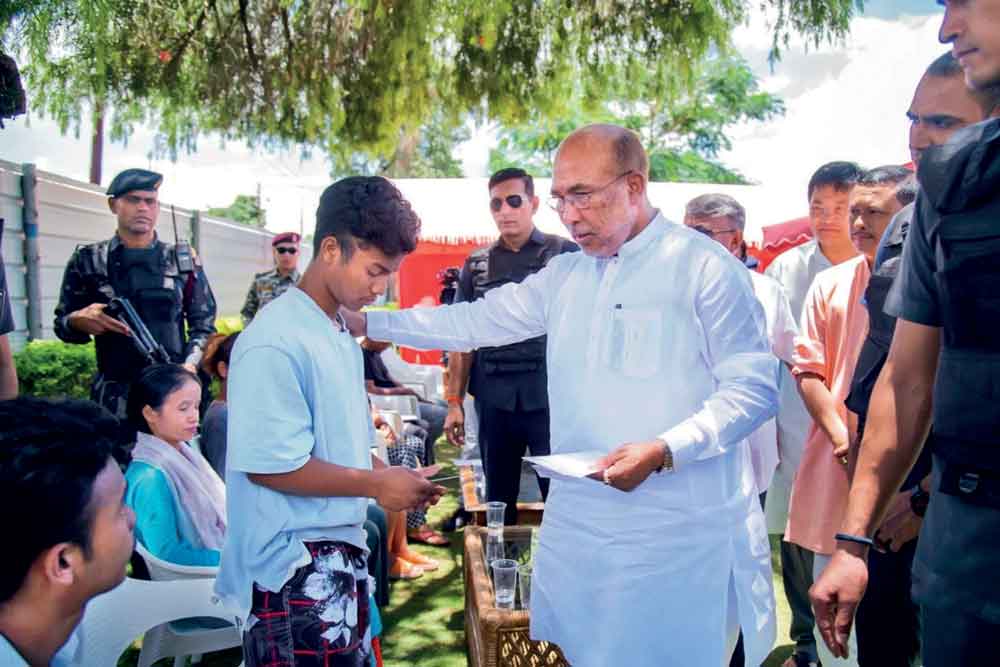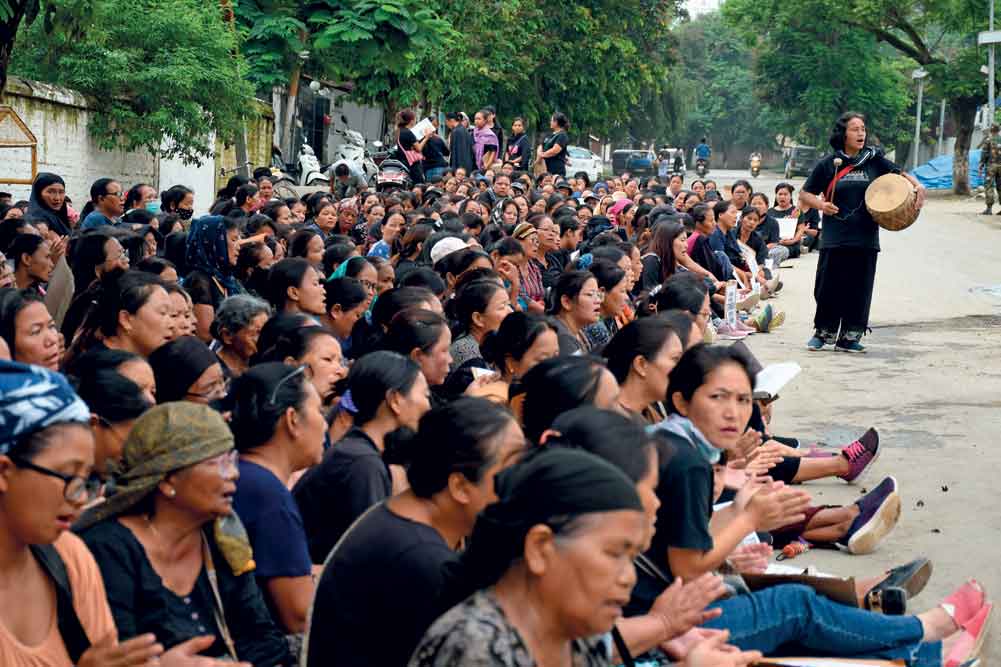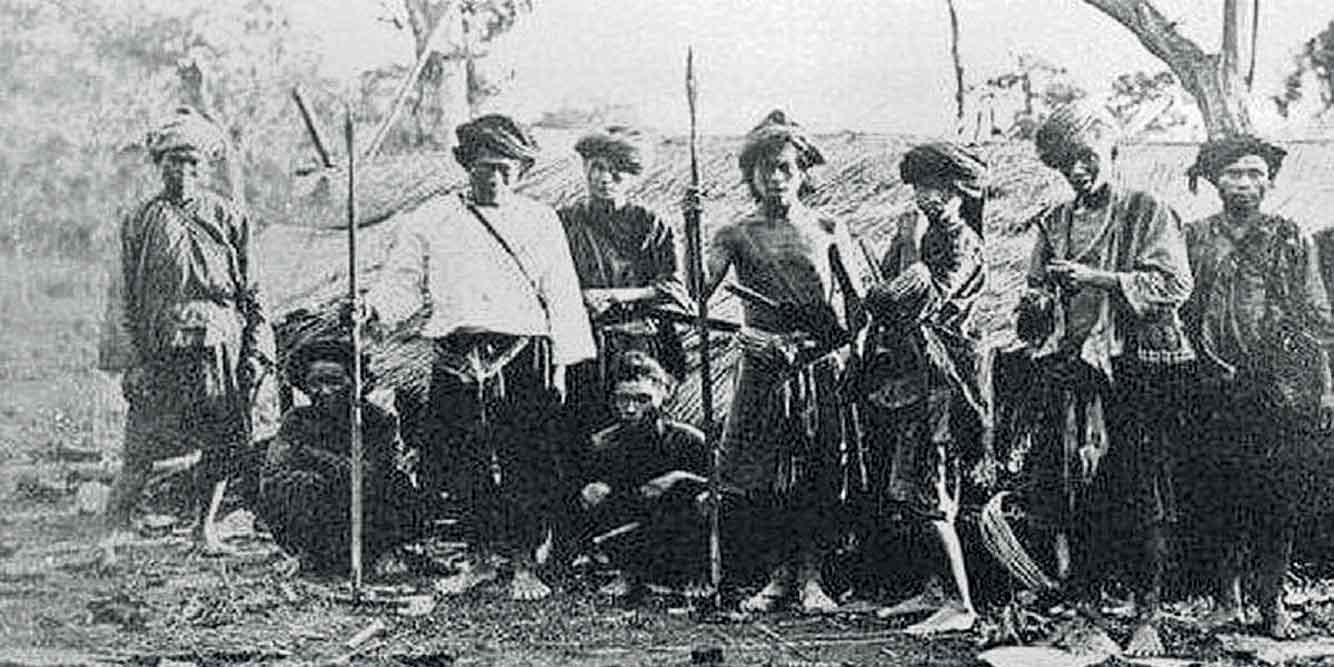In It Together
Caught between history, geography and demography, Manipur can achieve peace only by building trust. Peddling false narratives won’t help
 Ram Madhav
Ram Madhav
 Ram Madhav
Ram Madhav
 |
18 Aug, 2023
|
18 Aug, 2023
/wp-content/uploads/2023/08/InItTogether1.jpg)
Ema Market, the world’s largest women’s market, in Imphal (Photo: Shutterstock)
THE NORTHEASTERN STATE of Manipur witnessed a wave of ethnic violence in May this year that continued for several weeks. In Parliament, the opposition moved a no-confidence motion against the government on the issue.
Responding to the motion, Union Home Minister Amit Shah explained history, politics and the current situation of conflict in a brilliant and non-combative way. Maintaining that the conflict was a product of historical animosity among various ethnic groups, he appealed for not viewing it through a political prism.
Manipur is a state with a complex demography and geography that resulted in a complicated history. Conflict of interests is in a way built into the body politic of the state. The Imphal Valley of over 1,800 square kilometres constitutes over 10 per cent of the state’s territory that is surrounded by hills that constitute the remaining 90 per cent.
The demography, too, is complicated. The Meiteis are the majority ethnic group in the state.
A court chronicle of the 14-15th centuries called the Cheitharol Kumbaba traces the ancestry of the Meitei to the first king Pakhangba in 33 CE. A state with the name Kangleipak came into existence with a constitution in the 11th century under King Loiyumba.
The Meiteis practised a polytheistic religion called Sanamahism. It came under the influence of Vaishnavism in the 16-17th centuries when the royals adopted it. Many Meiteis continue to follow both Vaishnavaite and Sanamahist traditions. The name of the kingdom was changed from Kangleipak to Manipur during the reign of King Pamheiba in 1709-48.
While the Hindu Meiteis dwelled in the Imphal Valley, the hills were originally populated by tribes of Tibeto-Burmese origin. They were known as Thankhuls in the Meitei language but got identified with the Nagas of neighbouring Nagaland in the later centuries.
Conflicts between Manipuri and Burmese royals had been a regular feature in the medieval period. The British, too, waged three wars with the Burmese during 1824-85 and defeated them, making Burma a province of British India. They then turned their attention to Manipur and annexed it forcefully in 1891.
The turbulent war years of the 19th century witnessed migration of a third ethnic group into Manipur from the Lushai Hills in Mizoram and Chin State in Burma—the Kukis. Although a few thousand had traditionally lived in the Manipur hills, their numbers grew rapidly during this migration.
When Manipur joined the Indian Union in 1951, it consisted of three predominant ethnic groups—the Meiteis, the Thangkhul Nagas, and the Kukis. While the Meiteis occupied the Imphal Valley, the Kukis became dominant in the hills surrounding the Valley and the Nagas controlled the outer hill region. Thus, complex demographic rings of influence were created setting the stage for decades of conflict.
The opposition’s efforts to project the current conflict in Manipur as a new phenomenon are misplaced. Like the other regions in the Northeast, Manipur, too, witnessed conflicts of different proportions before and after independence that continue to cast their shadow even today.
During their forays into the Northeast, the British had a tough time taming the Nagas, but finally entered into a peace agreement in 1880. With the Kukis, their battles continued until Independence. A major conflict broke out between the Kukis and the British during 1917-19 when the Kukis refused to join the British Indian Army during World War I. The British subjected them to severe atrocities, including oppressive taxation and plunder. When the Kukis retaliated, the British burnt down hundreds of their villages, picked up innocents and used them as human shields against the attacks from Kuki rebels. It was one of the bloodiest chapters of Manipur’s history. That acrimony continued, and when Netaji Subhas Chandra Bose’s Azad Hind Fauj entered Manipur and battled it out with the British, the Kukis wholeheartedly supported it.

After independence, dependence on land for livelihood and survival became a major bone of contention among various communities. Although the Kukis and the Nagas occupy the hills that constitute almost 90 per cent of the state’s territory, they have access to only a limited part of it as over 78 per cent of the state’s territory is declared as reserved forest. Scarcity of land in the hills and lack of other avenues of livelihood result in Kukis and Nagas moving into the Imphal Valley that doesn’t have any restriction. Naturally, the Meiteis perceive it as an encroachment on their rights and resent it.
The Darwinian principle of ‘struggle for existence’ continues to plague the state. Situated next to the infamous ‘Golden Triangle’—the narcotics belt of Thailand, Laos and Myanmar—the region’s politics got further vitiated by illegal drug and weapons trade and gave rise to a serious insurgency.
Speaking in Parliament in 1987, George Fernandes had said, “There are eight insurgent groups in Manipur today and they are continuously engaged in encounters with the Indian Army.” He warned that “when the Northeast erupts, Kashmir would look like child’s play”.
The current conflict in Manipur is traced to a violent rally organised by the Kukis in Churachandpur on May 3, 2023 in protest against the Meitei demand for Scheduled Tribe (ST) status. But exactly 30 years earlier, on May 3, 1993, another major conflict had erupted in the state that too demonstrated the fragile nature of inter-ethnic relations.
On May 3, 1993, the Hindu Meiteis and the Muslim Meiteis, also called Meitei Pangals, got into a conflict over frivolous reasons. Longstanding suspicion about illegal immigration from Bangladesh and growing Muslim numbers added fuel to the fire. In the ensuing rioting and clashes, more than a hundred people, mostly Pangals, lost their lives. The situation turned so serious that then-Chief Minister Dorendra Singh appealed to the Centre that “only a big army deployment could contain the situation”.
While the Meitei-Muslim conflict was raging in the Valley, the hills were ravaged by another conflict between Nagas and Kukis over control of land. Insurgent groups on both sides, the National Socialist Council of Nagaland-Muivah (NSCN-M) and the Myanmar-based Kuki National Army (KNA), fought pitched battles that continued for many years and resulted in the deaths of more than 700 people.
An uneasy truce and an occasional outburst of violence have thus been a regular feature of the state in all these decades.
In the recent past, 2015-17 witnessed another bout of unrest due to the political expediency of the state government led by Okram Ibobi Singh. Facing intra-party rebellion during his third term in office, Ibobi Singh resorted to shrewd political machinations by announcing three controversial Bills in the Assembly.
Those bills were: one, Protection of Manipur People Bill; two, Manipur Land Revenue and Land Reforms Bill; and three, Manipur Shops and Establishments Bill.
Manipur is a land of great patriots. Meiteis, Kukis and Nagas have produced countless people who served India in politics, the armed forces and the civil services. Of the over 200 martyrs of the Azad Hind Fauj at Moirang more than 150 were Kukis
The first Bill divided the state’s population into Manipuris and non-Manipuris and sought to introduce a permit system for so-called non-Manipuris with 1951 as the cut-off year. The second Bill was intended to disallow the alienation of Meitei land in the Imphal Valley to outsiders. The spirit of Article 371C of the Constitution mandates that the state government consult tribal bodies before embarking on any far-reaching reform. However, the chief minister refused to consult the stakeholders and pushed the Bills through using his brute majority in the Assembly.
The hills erupted in protest as the Bills were perceived by the tribes as aimed at disempowering them. The unrest and violence led to the death of nine Kukis in police firing in Churachandpur in August 2015. Taking an aggressive posture, the tribal bodies decided not to bury the dead until the Bills were rescinded.
While this conflict was ongoing, the chief minister embarked on another rash decision that offended the Naga leadership. In October 2016, he announced the creation of two new districts by elevating the subdivisions of Sadar Hills and Jiribam. Once again, he refused to consult the Naga tribal bodies, calling it an administrative decision.
Clashes broke out between Nagas and Meiteis in Imphal Valley. The United Naga Council, the apex body of the Nagas of Manipur, announced a blockade of the two arterial national highways that connect the valley with the rest of the country—NH2 and NH37.
It was during this conflict that the Assembly elections were announced in the state. Forty of the 60 Assembly seats in Manipur are in the Imphal Valley where the Meiteis are in majority. Ibobi Singh was confident that riding over the Meitei support generated by his controversial Bills, he would be able to comfortably secure a majority. But when the results were declared, Congress fell short by three members of a simple majority.
Although the Bharatiya Janata Party (BJP) ended up securing six seats less than Congress in the final tally, it managed to stitch together a coalition with the support of the National People’s Party (NPP), the Naga People’s Front (NPF), and a couple of independents.
On March 15, 2017, the first-ever BJP government took oath of office with N Biren Singh as chief minister. Biren Singh was a veteran Congress leader and had held ministerial positions in successive Congress governments 2003 onwards. However, he fell out with Ibobi Singh in the latter’s third term and was denied a ministerial berth in 2012. He joined BJP towards the end of 2016.
As BJP’s Northeast in-charge, I had the opportunity to observe the leaders of the region from close quarters, including Biren Singh. Due to the fragile nature of the coalition and given the challenging internal situation that it inherited from the 15-year Congress rule, a leader who would be able to keep the alliance together and also manage the challenge from a strong opposition was needed to head the coalition government. With his vast experience and contacts in the opposition camp, Biren Singh fitted the bill well and was chosen to become the 12th chief minister of the state.

The first challenge that Biren Singh’s government tackled was the blockade by Naga groups. Quick negotiations with the Naga leadership led to termination of the 139-day blockade within a week after the new government was formed.
Negotiations began with the Joint Action Committee Against Anti Tribal Bills (JAC-AATB) headed by Kuki leaders in early April. At the very first meeting, Biren Singh declared that “Manipur is made up of Hills and Valley and without hills and tribals there is no Manipur”. It helped generate confidence among the tribal leaders about the sincerity of the new government.
Finally, in May, Churachandpur, “the town that refused to bury its dead”, witnessed the end of 632 days of a stand-off and the dead were taken out for their final rites.
These two major successes in the first two months led to people hailing the chief minister as the “unifier of hills and valley”. Sporadic incidents apart, the last six years of his rule did not experience any major blockade, curfew or conflict.
MANIPUR WAS NOT about ethnic conflict always. It witnessed great bonhomie too in the last five decades after acquiring statehood in January 1972. Though the Meiteis constituted nearly half of the population, leadership of the state came from different sections.
The first chief minister after statehood was Mohammed Alimuddin, although Muslims constituted only 8 per cent of the population. Two Naga leaders served as chief ministers of whom Rishang Keishing led the government for close to a decade. Kukis, too, held important portfolios in successive governments.
The present conflict is hence an aberration occasionally witnessed in the state due to the challenge of scarce land resources and fight for control over them.
It can be traced back to the hasty order of the high court on April 27, asking the state government to approach the Centre seeking extension of ST status to Meiteis. The court did not follow due legal process of seeking the opinion of the state and Central governments on such a sensitive matter before pronouncing its order.
Kukis reacted by organising a massive protest rally in Churachandpur on May 3 that turned violent. As rumours spread through the media and social media, retaliations by the Meitei groups began in the Valley. The barbarous incident of parading two Kuki women naked on the streets was part of that retaliatory violence.

Although swift action was taken by the Central government by replacing the state’s chief secretary and director general of police (DGP) within 48 hours and airlifting 36,000 Central Armed Police Forces (CAPF) personnel, violence peaked in the first two weeks before the new administrative machinery could take control, leading to most of the deaths. The situation was contained over the next few weeks through the deployment of the Army besides CAPFs and Manipur Police.
The Union home ministry is engaged in talks with the Meitei and Kuki groups for diffusing tensions. Amit Shah visited the state to supervise security arrangements. Nityanand Rai, minister of state (MoS) for home affairs, camped in Imphal for three weeks to oversee the restoration of peace. Manipur is limping back to normalcy.
A dispassionate analysis brings forth some important observations.
Six years of relative peace seems to have led to complacency in the state administration, not realising that the tinder box of ethnic strife is always ready to be ignited. The response time of the state machinery was long enough for the miscreants to unleash horrors that included ghastly killings and atrocities against women.
A major conflict broke out between the Kukis and the British during 1917-19. When the Azad Hind Fauj entered Manipur and battled it out with the British, the Kukis supported it
Although the horrific incident with two Kuki women rattled the conscience of the entire country, it must be kept in mind that Manipur takes pride in the frontline role its women always play. Meira Paibis, women torchbearers, are considered the “guardians of civil society” in the state. Ema Keithel or Ema Market in Imphal is the world’s largest women’s market with more than 5,000 women vendors. In fact, the Meira Paibis strongly protested the incident involving Kuki women and destroyed the house of the main perpetrator.
A major bone of contention for the Meira Paibi and Meiteis has been the role of Assam Rifles. A paramilitary force created by the British in 1835 to guard the India-Myanmar border, it is currently also deployed in the Manipur hills in counterterrorism (CT) operations. Assam Rifles are a CAPF under the home ministry but its leadership comes from the Army. This dual control has been causing several operational challenges, especially in inland operations. Deployed for decades in CT operations in the Manipur hills, it faces criticism from the Meiteis for a pro-Kuki bias. A proposal a few years ago to bring the force under the Army did not succeed. However, a review of the force’s functioning is necessary.
THE INDIA-MYANMAR BORDER had remained open since the 1960s by an agreement between the two countries. After the BJP government came to power in 2014, efforts began to seal the border. But they were delayed due to resistance from civil society groups in Manipur who claimed that the border demarcation was wrongly done, causing loss of territory to Manipur. Finally, the government commenced border fencing activity in 2021 and 10km of trial fencing has been completed and work is in progress on another 70km. A further 600km stretch is being surveyed for the same purpose.
The Kukis are the major northeastern tribe with a transnational presence in Myanmar, India and Bangladesh. The sealing of borders will pose a challenge to them. But it will put an end to Meitei fears about illegal immigration. The Central government also took steps to register Kuki immigrants and their biometric data is being corroborated with Aadhaar and voter cards.
The Kukis are largely Protestants. Some church organisations took advantage and tried to give a communal colour to the violence. They propagated all over the world that churches were being destroyed and Christians attacked.

Even the European Parliament became a victim of this propaganda and held a brief session on the Manipur violence. Some rightwing Members of the European Parliament (MEPs) attacked the Indian government with run-of-the-mill accusations about the ‘persecution’ of Christians and Hindu majoritarianism. A resolution containing many innuendoes far removed from reality was passed.
The Kuki leaders publicly stated that the violence had nothing to do with religion. In fact, in the violence that was unleashed during the Kuki protest march in Churachandpur, the first to be attacked was a Meitei temple. Several churches, too, were attacked by the Kukis since they belonged to Meitei Christians, who make up about 5 per cent of the Meitei population. If Christian leaders claimed that 250 churches were destroyed, Meitei elders like Lt General Niranjan Singh claimed that 392 temples were attacked. In both cases, it was the ethnic identity that mattered more than the religion. Earlier, when Nagas and Kukis battled with each other in the 1990s, religion never came to the rescue even though both communities were Christian.
The Archbishop of Bombay, Cardinal Oswald Gracias, released a four-minute video statement rejecting the propaganda of the Christian bodies, and putting the violence in proper perspective. “This is a tribal conflict between two tribes, historically very hostile to each other. And it exploded into violence because of certain legislation that were passed. It is given a religious twist, but it is not a religious conflict. It is not between two religions, it’s between two tribes”, he stated.
The narco trade is another big challenge in Manipur. Over the years, the Golden Triangle has moved westwards to encompass the Manipur hills too. But to blame any single community for the narco trade will be wrong as it has stakeholders from all communities. While poppy cultivation happens mainly in Kuki-dominated areas, investments come from the Valley and trading happens through many powerful satraps. The role of insurgent groups in the narco trade cannot be understated either. Sealing the borders will help prevent illicit drug trafficking.
The most important lesson is about narrative-building. Creating normalcy in Manipur depends on what narrative will be peddled. The opposition seems determined to resort to a false narrative both inside Parliament and outside for its political benefit. It will perpetuate strife, and peace will elude Manipuris.
Manipur is a land of great patriots. Meiteis, Kukis and Nagas have produced countless people who served the country not only in politics but also in the armed forces and the foreign, administrative, and police services. Of the over 200 martyrs of the Azad Hind Fauj at Moirang more than 150 were Kukis.
Despite tensions, the people of Manipur have been living together for centuries. Intermarriage among the three ethnicities is quite common. The state’s existing political character cannot be altered. Manipuris are destined by geography to live together in the future as well.
The need of the hour is to build trust. A political blame-game is its nemesis.

/wp-content/uploads/2025/07/Cover-Shubman-Gill-1.jpg)












More Columns
‘Fuel to Air India plane was cut off before crash’ Open
Shubhanshu Shukla Return Date Set For July 14 Open
Rhythm Streets Aditya Mani Jha